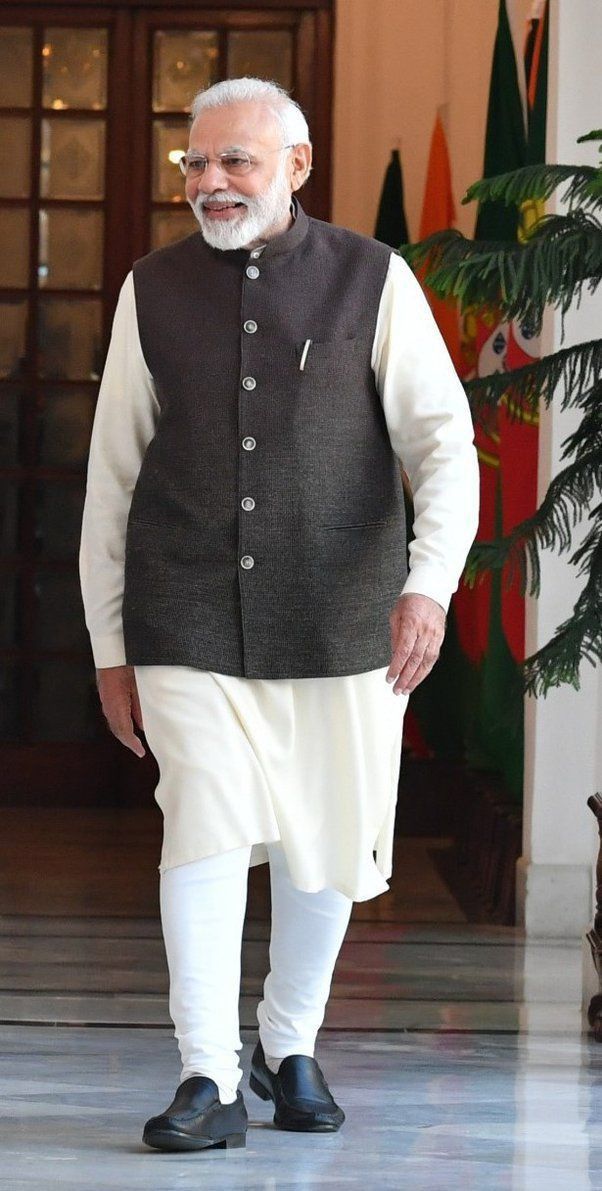Narendra Modi 2025: Prime Minister of India
Full Name: Narendra Damodardas Modi
Born: September 17, 1950, Vadnagar, Gujarat, India
Political Party: Bharatiya Janata Party (BJP)
Office: 14th Prime Minister of India (2014–present)
Previous Offices: Chief Minister of Gujarat (2001–2014)
Early Life and Background: Narendra Modi
Narendra Modi was born in Vadnagar, a small town in Gujarat, to a lower-middle-class family. His early life was marked by humble beginnings, and he was known to have helped his father sell tea at a railway station, an experience that Modi has often referenced as shaping his understanding of the struggles faced by ordinary people.
Modi completed his schooling in Vadnagar and developed an early interest in politics and social issues. He became involved with the Rashtriya Swayamsevak Sangh (RSS), a right-wing Hindu nationalist organization, at a young age. His association with the RSS played a pivotal role in shaping his political ideology and later career.
In his early adult years, Modi joined the Bharatiya Janata Party (BJP), a political party with strong ties to the RSS. Modi’s political rise began in Gujarat, where he initially took on the role of organizing campaigns and developing strategies for the party.
Political Rise and Chief Minister of Gujarat: Narendra Modi
Modi’s entry into state politics came when he was appointed as the Chief Minister of Gujarat in 2001, following the resignation of the previous chief minister. His tenure in Gujarat was marked by both significant economic growth and controversy. Under Modi’s leadership, Gujarat became known for its focus on economic development, industrialization, and infrastructure projects. The state saw an increase in foreign investments, and Gujarat became one of India’s most economically prosperous states.
However, Modi’s tenure was also marred by the 2002 Gujarat riots, in which violent clashes between Hindus and Muslims led to widespread destruction and loss of life. Modi’s handling of the riots was heavily criticized, and despite accusations of being complicit or failing to prevent the violence, he was never convicted. Over time, Modi’s image improved due to his strong governance style and economic reforms in Gujarat, but the controversy surrounding the riots remained a polarizing issue.
Despite the controversy, Modi’s popularity grew, especially among the middle class and entrepreneurial communities, who saw him as a leader focused on development and modernization.
Prime Minister of India: 2014–Present: Narendra Modi
2014 General Election Victory; Narendra Modi
In 2014, Narendra Modi led the BJP in a landslide victory in the general elections, securing an absolute majority in the Lok Sabha (the lower house of India’s parliament). Modi’s campaign was centered on themes of development, national security, and anti-corruption. His slogan “Ab ki baar, Modi sarkar” (This time, Modi’s government) resonated with voters across India, and his promise of delivering good governance and economic reforms helped him secure widespread support.
Modi’s victory marked the end of a decade-long period of Congress Party rule under Manmohan Singh, and his ascent to power signaled a shift in India’s political landscape toward more assertive nationalism, economic reform, and centralization of power.
Domestic Policies and Achievements; Narendra Modi
As Prime Minister, Modi has focused on a variety of domestic reforms aimed at modernizing India’s economy and governance. Some of the key initiatives and policies under his leadership include:
1. Make in India and Economic Reforms: Narendra Modi
Modi launched the Make in India campaign in 2014, aimed at transforming India into a global manufacturing hub. The initiative sought to attract foreign investments, create jobs, and encourage innovation in the manufacturing sector. He also introduced the Goods and Services Tax (GST) in 2017, which was one of the most significant tax reforms in India’s history, aimed at simplifying the country’s complex tax structure and boosting economic efficiency.
Additionally, Modi’s government has pursued financial inclusion through the Pradhan Mantri Jan Dhan Yojana, which seeks to provide bank accounts to every Indian, especially those in rural areas. This move was seen as an important step in bringing millions of people into the formal economy.
2. Digital India and Technology: Narendra Modi
Under Modi’s leadership, India has seen an accelerated focus on digitization and technology-driven development. The Digital India initiative launched in 2015 aims to enhance internet connectivity, promote digital literacy, and empower citizens through technology. The government has pushed for cashless transactions, e-governance, and e-commerce, helping India become one of the fastest-growing digital economies in the world.
3. Swachh Bharat Abhiyan: Narendra Modi
Launched in 2014, the Swachh Bharat Abhiyan (Clean India Mission) sought to clean up public spaces, improve sanitation, and eliminate open defecation. The campaign’s goals included building millions of toilets across rural areas and raising public awareness about hygiene and cleanliness. This initiative has been one of Modi’s flagship programs, and it has had a significant impact on public health and rural sanitation.
4. Demonetization and Economic Impact: Narendra Modi
In 2016, Modi announced a controversial decision to demonetize ₹500 and ₹1000 banknotes, with the goal of curbing black money, corruption, and counterfeit currency. The move had mixed results, with some praising it as a bold step against corruption, while others criticized it for causing economic disruption, especially in the informal sector.
5. Healthcare and Ayushman Bharat: Narendra Modi
In 2018, Modi launched the Ayushman Bharat Yojana, the world’s largest public health insurance scheme, which aims to provide financial protection to low-income families by covering medical expenses for hospitalization. This program has been hailed as a step toward improving healthcare access for millions of Indians.
6. National Security and Foreign Policy: Narendra Modi
Modi’s tenure has also seen a strong focus on national security and foreign policy. His government has been proactive in addressing issues like cross-border terrorism, especially in relation to Pakistan, and has taken a hard stance against militant groups operating in India. The 2016 surgical strikes in Pakistan-administered Kashmir and the 2019 airstrike on a terrorist training camp in Balakot, Pakistan, were among the high-profile actions taken by his administration.
On the global stage, Modi has worked to strengthen India’s ties with key global powers, including the United States, Russia, and countries in the Asia-Pacific region. He has championed India’s role in international forums like the United Nations, BRICS, and the G20.
Controversies and Criticism: Narendra Modi
While Modi’s leadership has garnered widespread support, it has also been the subject of significant controversy:
- Religious Polarization and Minority Rights: Critics argue that Modi’s government has promoted Hindu nationalism, which has led to concerns about the marginalization of India’s Muslim minority and other religious communities. The Citizenship Amendment Act (CAA), which grants citizenship to religious minorities from neighboring countries except Muslims, has sparked nationwide protests and criticism for allegedly discriminating against Muslims.
- Handling of the COVID-19 Pandemic: Modi’s handling of the COVID-19 pandemic has drawn mixed reactions. While the government’s initial lockdown in 2020 was seen as a necessary measure, the second wave of infections in 2021 overwhelmed the healthcare system, leading to criticism of the government’s preparedness and response.
- Farmer Protests: In late 2020, farmers in India began protests against three new agricultural laws that they believed would undermine their livelihoods. The protests, which lasted for over a year, were a significant challenge to Modi’s government, highlighting concerns about rural distress and agricultural policies.
Legacy and Future: Narendra Modi
Modi’s leadership has reshaped India’s political, economic, and social landscape. His focus on development, national security, and global influence has elevated India’s position on the world stage. However, his government’s policies on religion, freedom of speech, and minority rights have raised concerns about the direction in which India is heading.
As India approaches the 2024 general elections, Modi’s popularity remains strong, but his government faces significant challenges. His legacy will likely be defined by his ability to balance economic progress with social harmony, while navigating India’s complex internal and external challenges.
Under Modi, India has seen growth and modernization, but the question of whether it can retain its democratic values amid increasing nationalism and centralization of power will be crucial in shaping the country’s future.










